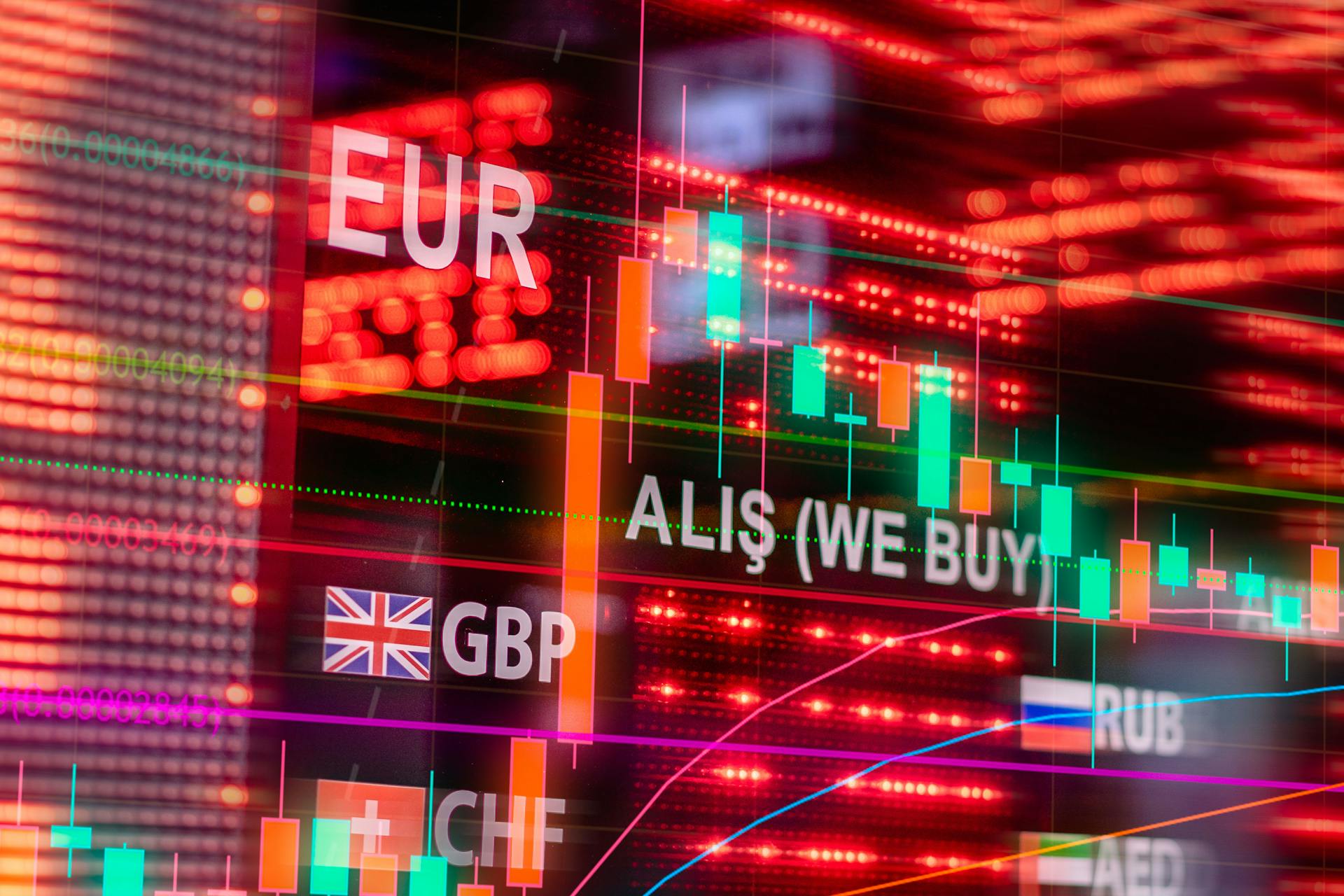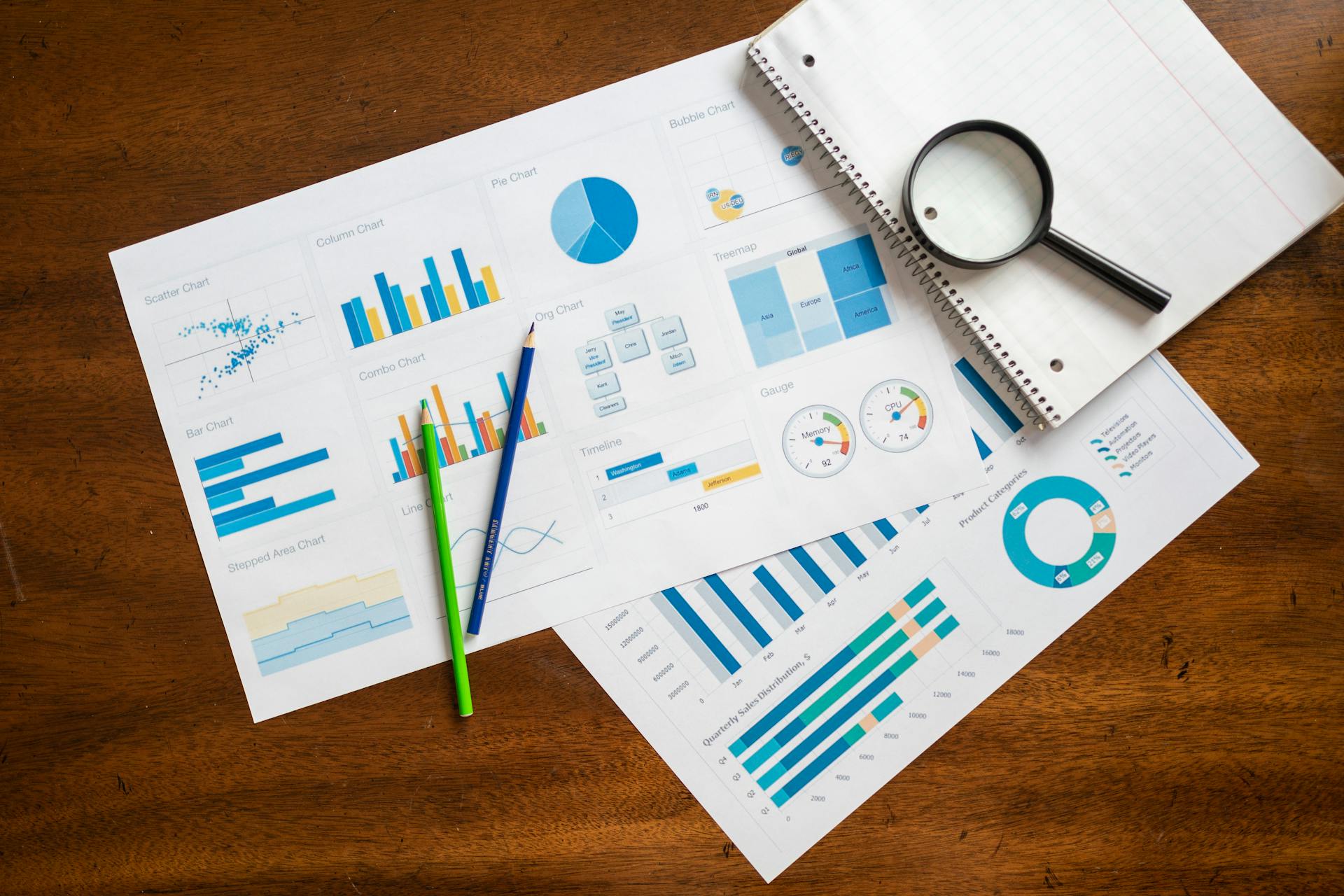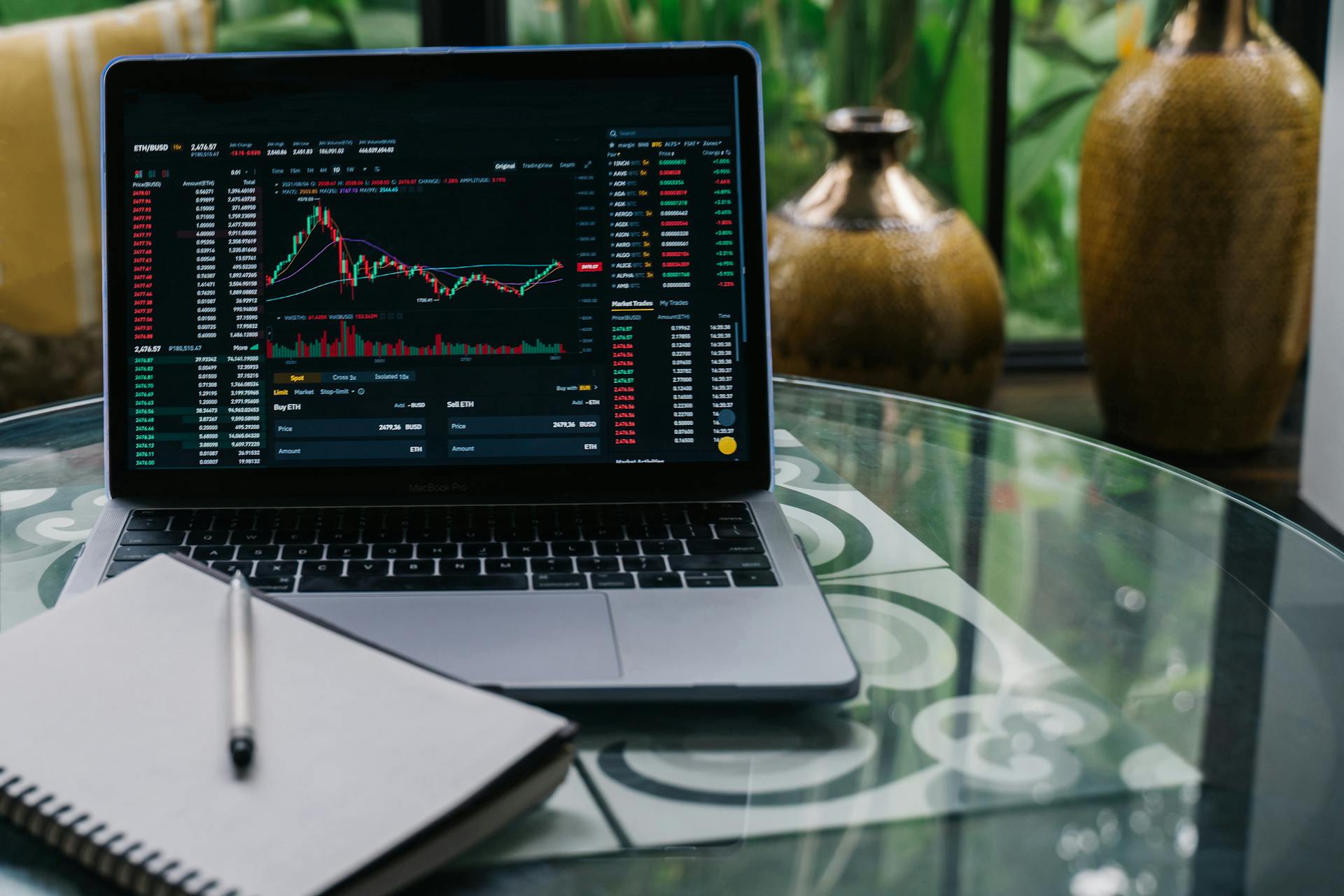
Chart currency trading can be overwhelming, but it doesn't have to be. By understanding the basics, you can make informed decisions and trade with confidence.
First, it's essential to know that currency pairs are traded in pairs, with one currency being exchanged for another. For example, the EUR/USD pair represents the exchange rate between the Euro and the US Dollar.
Understanding the major currency pairs is crucial, as they account for the majority of global transactions. The most liquid pairs, such as EUR/USD and USD/JPY, are often the most traded.
By analyzing charts, you can identify trends and patterns that can help you make better trading decisions. For instance, a rising trend on the EUR/USD chart may indicate a strong Euro.
Readers also liked: Euro Currency Uk
Market Participants
The foreign exchange market is a complex and diverse place, with a wide range of participants involved in its daily transactions. These participants include governments and central banks, commercial banks, other institutional investors and financial institutions, currency speculators, other commercial corporations, and individuals.
Top-tier interbank market accounts for 51% of all transactions, with the largest players being commercial banks and securities dealers. JP Morgan, UBS, and XTX Markets are among the top 10 currency traders, accounting for a significant share of overall volume.
The foreign exchange market is divided into levels of access, with the top being the interbank foreign exchange market. Within this market, spreads represent the gap between the bid and ask prices in trading. Banks with reserve imbalances may prefer to borrow from banks with established relationships and can sometimes secure loans at more favorable interest rates.
Here's a breakdown of the top 10 currency traders, based on their market share in June 2020:
Investment management firms, such as pension funds and endowments, use the foreign exchange market to facilitate transactions in foreign securities, generating large trades and profits.
Worth a look: International Equity Trading
Investment Management Firms
Investment management firms play a significant role in the foreign exchange market, using it to facilitate transactions in foreign securities. They manage large accounts on behalf of customers such as pension funds and endowments.
These firms need to purchase and sell several pairs of foreign currencies to pay for foreign securities purchases. For example, an investment manager bearing an international equity portfolio needs to purchase and sell several pairs of foreign currencies to pay for foreign securities purchases.
Some investment management firms have more speculative specialist currency overlay operations, which manage clients' currency exposures with the aim of generating profits as well as limiting risk. These firms have a large value of assets under management and can generate large trades.
According to Galati and Melvin, pension funds, insurance companies, mutual funds, and other institutional investors have played an increasingly important role in financial markets, including the FX markets, since the early 2000s.
Additional reading: Bitcoins Trade Investment
Retail Forex Traders
Retail Forex traders are a growing segment of the market, participating indirectly through brokers or banks. They can be found in many countries, including the US, UK, and emerging markets like South Korea, South Africa, and India.
Related reading: What Country Uses Rand as Currency
Retail traders can access the Forex market through online portals, which have made it easier for them to trade. In 2010, retail trading was estimated to account for up to 10% of spot turnover, or $150 billion per day.
The Commodity Futures Trading Commission and National Futures Association regulate retail brokers in the US. However, some brokers have been subjected to foreign exchange fraud in the past.
Retail FX brokers come in two main types: brokers and dealers or market makers. Brokers act as agents for the customer, seeking the best price in the market and dealing on behalf of the retail customer. Dealers or market makers, on the other hand, typically act as principals in the transaction versus the retail customer, and quote a price they are willing to deal at.
Retail traders can expect to pay a commission or "mark-up" in addition to the price obtained in the market when using a broker.
Discover more: What Percent of Day Traders Lose Money
Top Traded Currencies
The top traded currencies are a major focus for market participants. The US dollar is the most widely traded currency, accounting for over 80% of all foreign exchange transactions.
The euro is the second most traded currency, with a significant portion of its transactions occurring in the European Union. It's often paired with the US dollar in currency trading.
The Japanese yen is another highly traded currency, particularly in Asia. Market participants often use it to hedge against fluctuations in the value of the yen.
The British pound is also a major player in the foreign exchange market, with a significant portion of its transactions occurring in the UK.
Here's an interesting read: Currency Trading News
Determinants of Exchange Rates
Determinants of exchange rates are complex and multifaceted, influenced by a variety of economic, political, and market psychology factors.
Economic factors play a significant role in determining exchange rates, including government fiscal and monetary policies, which can impact interest rates and the supply of money. Government budget deficits or surpluses can also affect currency values, with widening deficits typically leading to a decline in currency value.
Worth a look: Fiat Currency Exchange Trading
Economic conditions, such as inflation levels and trends, economic growth and health, and productivity, also have a significant impact on exchange rates. For example, a country with high inflation may see its currency lose value, while a country with strong economic growth may see its currency strengthen.
Here are some key economic factors that influence exchange rates:
- Government fiscal policy (budget/spending practices)
- Monetary policy (interest rates)
- Balance of trade levels and trends (trade deficits or surpluses)
- Inflation levels and trends
- Economic growth and health (GDP, employment levels, etc.)
- Productivity of an economy
After 1973
In 1981, the People's Bank of China allowed certain domestic "enterprises" to participate in foreign exchange trading, marking a significant shift in the country's economic policies.
The South Korean government ended Forex controls and allowed free trade to occur for the first time in 1981, paving the way for a more open and dynamic economy.
By 1988, the South Korean government had accepted the IMF quota for international trade, further solidifying its commitment to free market principles.
In 1985, European banks, particularly the Bundesbank, exerted significant influence over the Forex market, demonstrating the important role that central banks play in shaping global financial trends.
The United Kingdom was the country with the greatest proportion of all trades worldwide in 1987, accounting for slightly over one quarter of all transactions.
A unique perspective: Forex Day Trader
What Is Eur/Usd?
The EUR/USD exchange rate is a currency pair that represents the value of the euro in terms of the US dollar. It's one of the most widely traded currency pairs in the world.
The value of the EUR/USD exchange rate is influenced by the interest rate differential between the European Central Bank and the Federal Reserve. The interest rate differential is a key factor in determining exchange rates, as it affects the attractiveness of each currency to investors.
The EUR/USD exchange rate can also be affected by the economic performance of the eurozone and the US. A strong economy with high growth and low inflation can lead to an appreciation of the currency.
The EUR/USD exchange rate is typically quoted as a price for one euro in terms of US dollars, with the price fluctuating constantly due to market forces. This means that the value of the EUR/USD exchange rate can change rapidly over short periods of time.
The EUR/USD exchange rate is widely used as a benchmark for other currency pairs, and its value can have a significant impact on international trade and investment.
For your interest: Can You Trade Xauusd in the Us
Central Banks
Central banks play a crucial role in the foreign exchange markets. They try to control the money supply, inflation, and/or interest rates and often have official or unofficial target rates for their currencies.
National central banks have substantial foreign exchange reserves that they can use to stabilize the market. Central banks can use these reserves to intervene in the foreign exchange market, but their effectiveness is doubtful.
The mere expectation or rumor of a central bank's foreign exchange intervention might be enough to stabilize the currency. Central banks do not always achieve their objectives, and the combined resources of the market can easily overwhelm any central bank.
Central banks do not go bankrupt if they make large losses, unlike other traders, which can lead to questionable market behavior.
Related reading: Real Time Currency Rates
Economic Factors
Economic factors play a significant role in determining exchange rates. A country's economic policy, disseminated by government agencies and central banks, can impact the value of its currency.
Government fiscal policy, which includes budget and spending practices, can influence exchange rates. For instance, a widening government budget deficit can negatively impact a nation's currency.
The balance of trade levels and trends also matter. A country with a trade surplus, indicating a high demand for its goods and services, tends to have a stronger currency. On the other hand, a trade deficit can weaken a currency.
Inflation levels and trends can also impact exchange rates. A high level of inflation can erode a currency's value, while expectations of rising inflation can lead to a strengthening of the currency.
Economic growth and health are also crucial. A country with a robust economy tends to have a stronger currency, while a struggling economy can lead to a weaker currency.
Here are some key economic indicators that can impact exchange rates:
- Government budget deficits or surpluses
- Balance of trade levels and trends
- Inflation levels and trends
- Economic growth and health
- Productivity of an economy
These indicators can influence the value of a currency and are often taken into account by investors and traders when making decisions about exchange rates.
Financial Instruments
Financial Instruments play a crucial role in currency trading, and understanding them is essential for success. The article highlights the importance of financial instruments in facilitating currency trading, making it easier for investors to buy and sell currencies.
Forex (FX) is the most liquid financial instrument in the world, with a daily trading volume of over $6 trillion. This massive market provides opportunities for investors to buy and sell currencies.
Options contracts allow investors to speculate on currency price movements without actually owning the underlying currency. This can be a useful tool for managing risk and maximizing potential gains.
Currency futures contracts are standardized agreements to buy or sell a specific currency at a set price on a specific date. They can be used to hedge against potential losses or to speculate on future currency price movements.
In the article, it's mentioned that the most popular financial instruments used in currency trading are Forex, options, and futures contracts. These instruments are widely available and can be easily traded through online platforms.
On a similar theme: Difference between Buy Stop and Buy Limit Order
Technical Analysis
You can add up to 70 technical indicators to your graph, including Linear Regression, CCI, ADX, and many more.
Technical analysis involves studying historical chart patterns and formations to predict the future direction of a market's price.
Using technical analysis, you can forecast FX prices and identify potential trading opportunities based on the relationship between consecutive candlesticks or HLOC bars.
Technical Indicators
Technical indicators can help you make sense of the chaos in the markets. You can add up to 70 technical indicators to your graph, including Linear Regression, CCI, ADX, and many more.
These indicators can provide valuable insights into market trends and patterns. They can be used to identify potential trading opportunities and help you make informed decisions.
Technical indicators can be divided into two main categories: trend indicators and momentum indicators. Trend indicators help identify the direction of the market, while momentum indicators measure the speed and strength of the trend.
Suggestion: London Stock Market Open Time
Some popular trend indicators include moving averages and Bollinger Bands, which can help identify support and resistance levels. Momentum indicators, on the other hand, include the Relative Strength Index (RSI) and the Stochastic Oscillator, which can help measure the speed and strength of the trend.
Here are some of the technical indicators that you can use in your analysis:
By using these technical indicators, you can gain a deeper understanding of the market and make more informed trading decisions. Remember, technical indicators should be used in conjunction with other forms of analysis, such as fundamental analysis and market news, to get a complete picture of the market.
Modifiers in a Sentence
Modifiers can be used to adapt a forex trading strategy to reduce risk exposure.
A foreign exchange option, for instance, gives the owner the right but not the obligation to exchange money at a pre-agreed exchange rate.
Using a forex strategy with a foreign exchange option can provide additional information for a trade.
Additional reading: Currency Carry Trade Strategy
Dojis
A doji occurs when the opening and closing prices are equal (or very close together), creating a black cross.
This is indicative of indecision in the market, with neither buyers nor sellers able to assert sufficient influence over the direction of price movements.
On its own, a doji is a neutral pattern of little significance.
However, if a doji forms within an uptrend or downtrend, it may indicate that a reversal is on the way.
Line
A line chart is a simple way to display pricing data, showing only the close price for the time period you've selected.
This type of chart is great for assessing long-term trends, where the high, low, and open prices may not be as relevant.
Line charts join consecutive close prices together to form a line, making it easy to visualize trends over time.
They're not as useful for short-term trading, where the high, low, and open prices can provide more valuable information.
Many forex traders use line charts to get a big-picture view of market movements, where the focus is on the overall trend rather than short-term fluctuations.
See what others are reading: Fpga Hft
Bounce
The bounce strategy is a popular approach in forex trading. It's based on the idea that markets tend to revisit significant levels, and if they bounce back from those levels in the past, they might do so again.
Many traders believe that if a market dropped to a specific level and then bounced back, that level becomes a potential support zone. This is because the market viewed that level as a good place to buy.
Forex traders often look for levels that have been important in the past, as they may be important again. This is the core of the bounce strategy.
If this caught your attention, see: Do Day Traders Make Money
Frequently Asked Questions
Is forex trading profitable?
Forex trading can be profitable, but success often depends on the timeframe and strategy used. Short-term gains are possible, but long-term profitability requires careful planning and execution.
What is a chart in forex trading?
A chart in forex trading is a visual representation of a currency pair's price movement over a specific time period, showing trading activity and trends. It's a valuable tool for traders to analyze market behavior and make informed decisions.
Can I trade forex with $100 dollars?
Yes, you can trade forex with $100, but keep in mind that even with a small deposit, you can potentially earn significant returns, such as over 10% per month with medium-level experience.
Where can I get forex charts?
You can access free live Forex charts on Dukascopy Bank SA's website, which provides a user-friendly widget for analyzing various markets. Their charts cover Forex, Commodities, precious metals, stocks, ETFs, indices, crypto, and bonds.
What are the tickers for forex?
The major forex pairs have tickers such as EURUSD, USDJPY, GBPUSD, and USDCHF. These four pairs are the most widely traded and closely watched in the foreign exchange market.
Featured Images: pexels.com


